While 4×2 vehicles are capable on the road, do they go off-road? This article explores challenges like traction and ground clearance. It also covers how to overcome these challenges with some minor vehicle modifications.
Going off-road is not practical for 4×2 vehicles because they lack the necessary attributes to enhance the vehicle’s capability when driving off-road. When you drive up and down hills with loose dirt and gravel, your 4×2 vehicle may get stuck due to lesser traction.
What is 4×2?
4×2 means four wheels on two axles. In a 4×4 vehicle, the engine is powering all four wheels with equal torque. The transmission in a 4×2 vehicle sends most of its power to just two of the wheels through a transfer case and a differential axle.
Can 4×2 Go Off-Road?
4×2 can go off-road, but these are not specially designed for this extreme activity. These vehicles can endure the tough challenges imposed by off-roading by undergoing modifications. These modifications include bigger and wider tires, a differential lock, a better suspension, higher ground clearance (a lift kit), and limited-slip differentials (LSD).
We have created the infographic below that covers whether 4×2 can go off-road. (You are welcome to use and share but please credit us if you do so.)
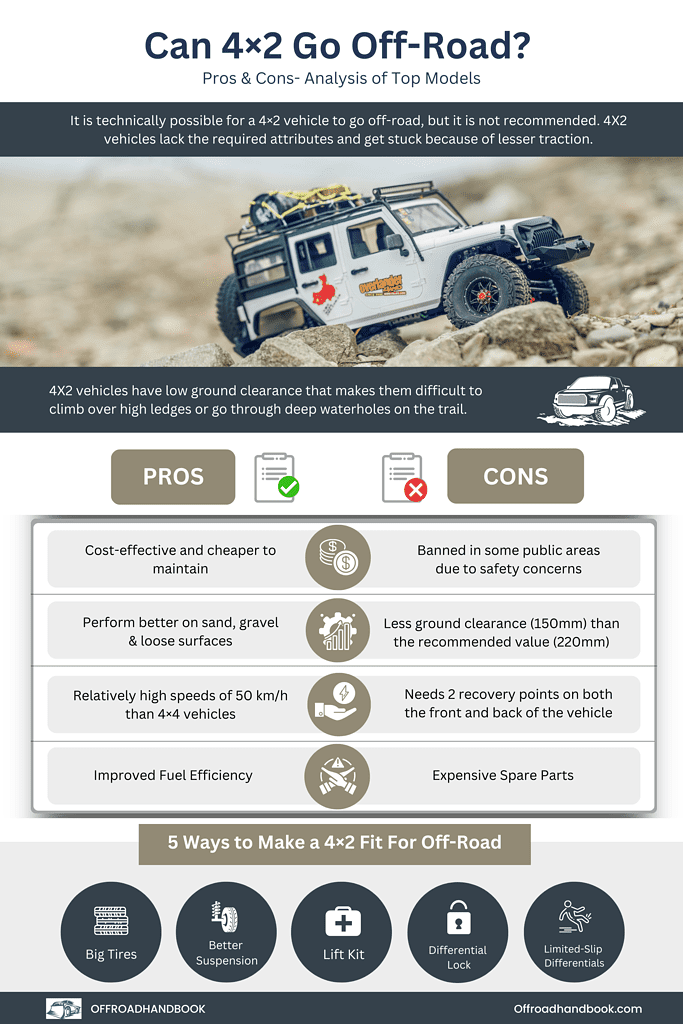
The following features are needed to drive a vehicle on unpaved terrain:
- Front axle differential lock (locking the driveshaft going to the front wheels)
- Rear axle differential lock (locking the driveshaft going to the rear wheels)
- High ground clearance, perhaps with underbody guards.
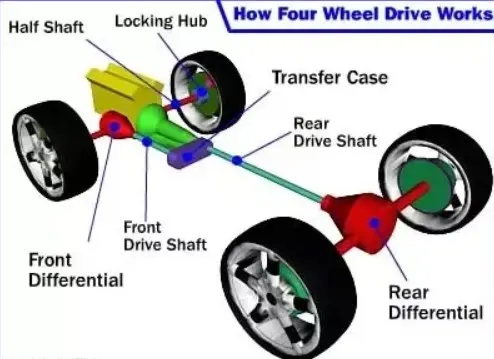
A solution for 4×2 may be buying a set of fender flares that can keep rocks and mud away from the undercarriage of your 4×4 vehicle. Another option is lifting one of your wheels using an aftermarket lift kit, so you increase ground clearance by up to 3 inches.
Possible Challenges While Off-Roading with 4×2:
- An unmaintained 4×2 vehicle is more likely to slip while off-roading.
- A 4×2 vehicle cannot go through small spaces even with its differential locks disengaged, while a 4×4 can do so easily.
- On soft surfaces like dunes or beaches, your 4×2 vehicle will most definitely get stuck.
- 4×2 vehicles are better used on dry and hard terrains than soft or slippery ones because they cannot easily get traction on these kinds of grounds. Getting stuck in the mud or sand despite your differential locks engaged will result in no forward movement, which could be dangerous if there are incoming cars behind you, so always check your surroundings to stay safe when using 4×2.
- Low ground clearance makes it very hard for 4×2 vehicles to climb over high ledges or go through deep waterholes on the trail.
- The next challenge for driving 4×2 off-road is traction. Since there are no differential locks, both front and rear axles get their torque equally distributed between the two tires (50/50). If one tire cannot grip onto dirt because it’s slipping, neither does the other tire that gets nothing while the slipping one is getting all the torque.
- If you’re going through a slippery area with the loose ground, then both front and rear wheels may start to spin at the same time, which can cause your 4×2 vehicle to be stuck in that spot.
- An additional challenge of using 4×2 is footing. It would help if you had very wide footprints (tires) for 4×4 vehicles, so they don’t sink into loose soil or powdery snow. A stock 4×2 vehicle will not have this kind of tire which means you should avoid soft surfaces like dunes, beaches, or even grasslands because sinking is likely to happen.
Can I drive my 4×2 vehicle on a non-paved Road?
While it’s technically possible for a 4×2 vehicle to go off-road, it’s not advisable to do so. Most off-road racing organizations ban 4×2 vehicles in their competitions because they lack the necessary attributes needed for this driving.
Pros of Off-Roading with 4×2:
- You don’t need to buy an expensive 4×4 vehicle.
- There are fewer components involved, so less can break.
- It’s cheaper to maintain a 4×2.
- Many 4×2 vehicles have front-wheel drive, so the torque is only sent to one wheel. This makes a vehicle perform better in sand or gravel because it has an improved grip on loose surfaces.
- Driving on the sand, you can get away with driving at relatively high speeds of 50 km/h, while most 4×4’s can go up to 60km/h max.
- You get better fuel economy compared to a 4×4 model.
Why You May Avoid Buying 4×2 for Off-Roading:
In the end, there are plenty of reasons why you should buy a stronger and more capable 4×4 instead of a weaker 4×2 vehicle. The price difference between a stock standard car and a car with a lift kit is usually roughly about $1,000 to $5,000, which makes up for the cost in just one or two years if you take your 4×4 off-road often.
For example, spare parts for your 4×4 are more reasonably priced than 4×2 vehicles.
- Some places have laws that ban 4×2 vehicles from being driven off public roads, so your car may not be legal to drive if it is not equipped with the necessary parts for this driving.
- You will also need recovery points on both the front and back of your vehicle, which can make parking or navigating difficult because you’ll probably need to install 2 recovery points (one on front and one on back) instead of just one like what is found in most 4×4’s.
- Finally, the ground clearance (measured in mm or inches) should be at least 220mm compared to 150mm for a normal car.
Differences Between 4×4 and 4×2 in Off-Road:
- 4X4 vehicle has a low range gearbox which provides better torque for off-road.
- In the event of a puncture, 4×4 can recover with one wheel spinning while the other wheel keeps traction even when going at very slow speeds.
- 4×4 Can go through soft or loose dirt without getting stuck easily.
- All four wheels provide power instead of just two like a 4×2 vehicle.
- 4×4 Can go at a higher speed across water surfaces.
- The torque is equally distributed between the four wheels, which means they all have equal traction and power most of the time.
- If you need to pull yourself out with a rope or cable, 4×4 can do so more easily than with a 4×2 vehicle.
- In an off-road situation where you are just about to get stuck, one wheel could be slipping while the other 3 are still powering your vehicle. If this happens, switch into low gear 1st or 2nd gear which disables one of the wheels that started to slip to gain a better grip on slippery grounds.
Does 4×2 Mean 4wd?
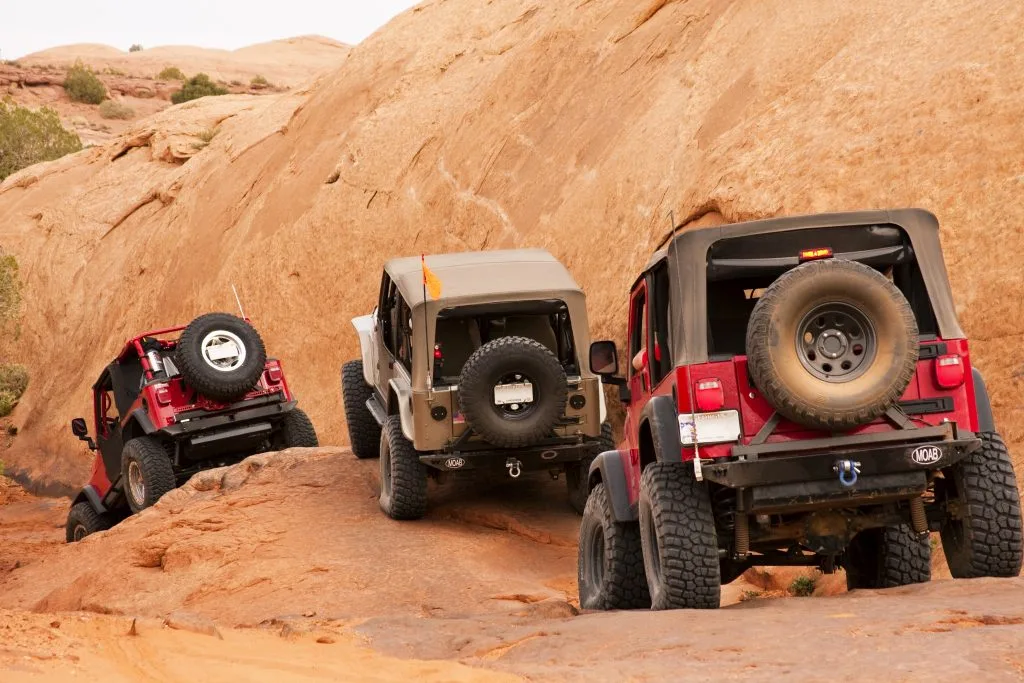
Generally, the answer is no. Many people assume that 4×2 means 4wd but this naming method was used in the past when cars were not equipped with ABS brakes, which are now standard equipment on all modern vehicles.
If you look at your average family sedan, it’ll most likely be a front-wheel-drive (FWD) model or a rear-wheel-drive (RWD) model instead of having all four wheels driven.
If you do find one with FWD/AWD/4X4/4x2 - know that AWD stands for All Wheel Drive while 4x4 stands for Four Wheel Drive. The former sends power to all 4 wheels while the latter only needs them to function properly since the other 2 wheels cannot rotate, and that is why 4x2 does not mean 4wd.
When it comes to the more expensive models such as SUVs, pick-ups, you can find those with heavy-duty axles such as dana 44. So if anyone tells you they have a “4×2” car or truck, then what they most likely mean is that their vehicle has front-wheel drive (FWD) instead of rear-wheel drive (RWD).
What Does 4×2 Mean on a Jeep?
The term 4×2 means the vehicle is a two-wheel-drive instead of a four-wheel drive.
For example, the Jeep Wrangler's FWD models are called '4x2' while their RWD models are called "4x4". It is not uncommon for people with such vehicles to mistake them for being 4wd because most off-roaders usually have all four wheels driven - this includes many sand rail buggies and trucks with the front and rear axles locked together.
Some car manufacturers name their AWD models as “4×4”, so when in doubt, search online, and you’ll find out what your specific vehicle model is classified as FWD or AWD/4×4/4×2.
What Does 4×2 Mean on a Ford?
Ford’s lineup doesn’t include many FWD configurations, so what you see more often from this manufacturer is either AWD/4×4/4×2 or RWD, usually on small displacement economy engines.
Ford mostly uses the AWD system because it's a combination of an FWD and 4WD into one package, which is more convenient for American customers who love to commute in everyday sedans that have a lot of passenger space but aren't as fuel-efficient as their foreign counterparts from Honda, Toyota, Mazda etc.
In other words: Ford mostly uses familiar AWD systems instead of FWD because most Americans prefer this type of drivetrain setup compared to what they are normally used to back home – this is why you see many affordable SUVs from Ford being advertised as being “all-wheel drive”.
Is 4×2 Front-Wheel Drive?
Yes, it is. Some 4×2 vehicles have part-time 4WD set-ups, but these types of drivetrain systems complicate the car and cost more money in the long run, so most manufacturers come with simpler FWD configurations instead, which have fewer components to go wrong.
Typically, you won’t see an RWD configuration on affordable or compact class family sedans because they don’t need it – this is where the term “4×2” comes from simple front-wheel drive (FWD) set-ups for budget cars and small displacement engines like 1.3L and 1.2L units.
Some even theorize that manufacturers choose FWD over AWD/4×4/4×2 on certain models simply because the FWD layout is cheaper to manufacture, and fewer components need to be created. And then other manufacturers go for a full-time 4WD system, but instead of having front and rear axles locked together, they use an open differential which splits engine power between all 4 wheels.
Best 4×2 Vehicles for Off-Roading:
1) Nissan Pathfinder:

Description: The Nissan Pathfinder is a good 4×2 vehicle if you want to do some light off-roading. It’s equipped with a rear limited-slip differential which helps in low traction situations while the engine is powerful enough to pull the car out of hard situations.
Pros: Great ground clearance, excellent suspension, and comes standard with a rear limited-slip differential that reduces wheel spin
Cons: It can get costly when modifying the vehicle for heavy off-road use.
2) Toyota Hilux:
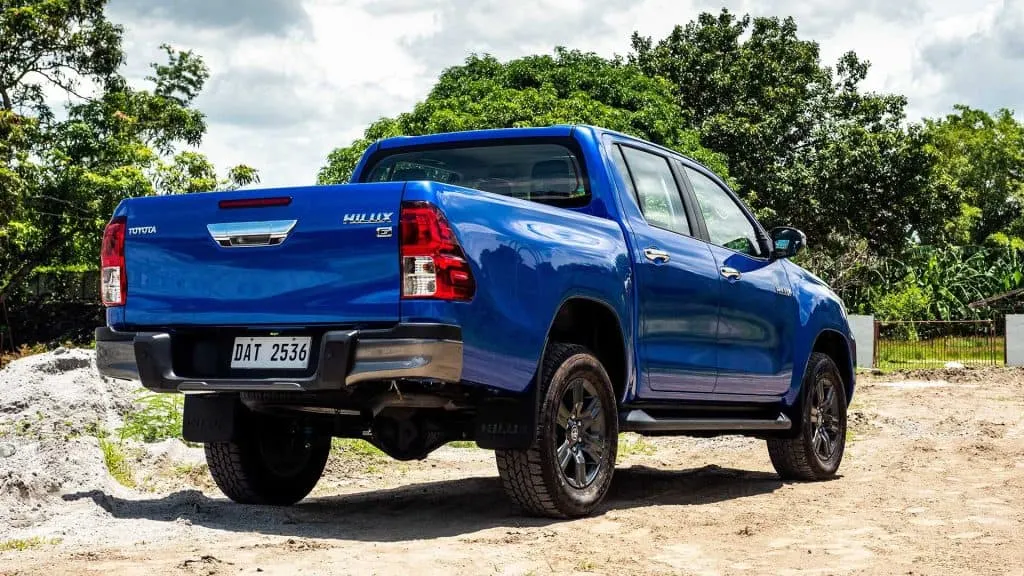
Description: The Toyota Hilux is a great 4×2 vehicle to use for off-road driving. It’s built like a tank and is extremely sturdy, so it can go off-road without having too many problems. It has an excellent narrow clearance, making it easier to drive through bushes or trees when in an off-road situation.
Pros: Great ground clearance, excellent suspension system, solid construction that holds the components well together, high reliability compared to other 4×2 vehicles
Cons: Can be expensive depending on the model selected.
3) Mitsubishi Challenger MT:

Description: The Mitsubishi Challenger is a 4×4 that can be driven 4×2. It can also switch from full-time four-wheel drive to part-time four-wheel drive, making it ideal for off-roading.
Pros: Great ground clearance, high reliability compared to other 4×2 vehicles, solid construction that holds the components well together, excellent suspension system
Cons: It can get pricey when modifying the vehicle for extreme off-road use.
4) Mitsubishi Pajero TR4 Flex 4×2:
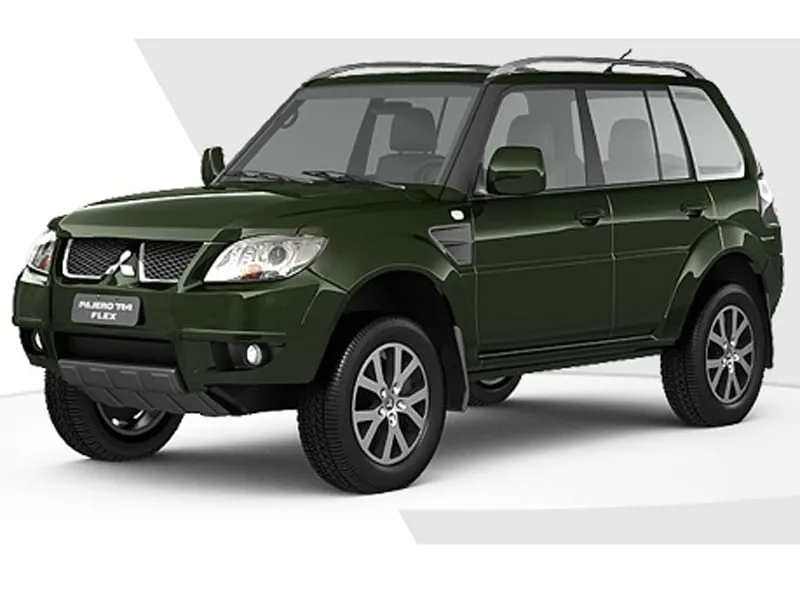
Description: This is a good 4×2 for off-roading. It has excellent all-terrain tires and high ground clearance, making it more capable on tough roads than most other vehicles in its class.
Pros: Great ground clearance, powerful engine, high reliability compared to other 4×2 vehicles, solid construction that holds the components well together
Cons: It can get costly when modifying the vehicle for off-road use
5) Isuzu D-Max:
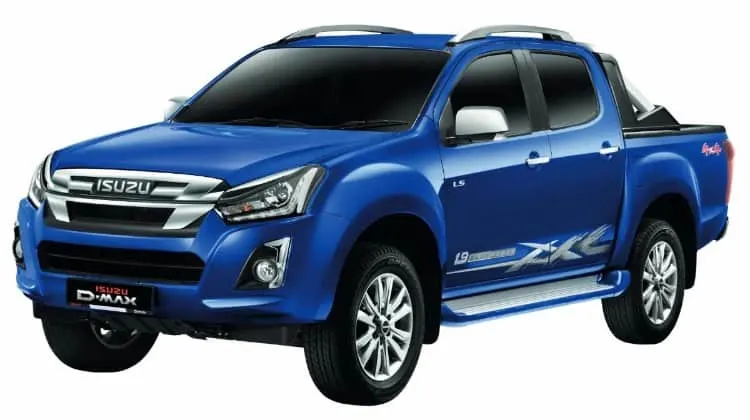
Description: The Isuzu D-max is a great 4×2 vehicle with an impressive fuel economy, making it ideal for heavy work such as off-roading. It’s built like a tank and will last you long if you treat it right. It has a high level of durability and is very easy on the wallet when it comes to maintenance.
Pros: Impressive fuel economy, solid construction that holds the components well together, powerful engine, high reliability compared to other 4×2 vehicles
Cons: It can get pricey when modifying the vehicle for heavy off-road use.
Final Thoughts:
4×2 vehicles can go off-road, but it’s important to consider what type of terrain you will be driving in and the cost of modifications before buying. 4×2 vehicles are often lower profile than 4×4, making them easier to maneuver through sand and mud.
However, all-wheel drive is more reliable with passing through deep puddles of water. Whether your vehicle is 2-wheel or 4-wheel drive, it is good practice always to take caution when driving into unknown terrain that may contain hazards such as large rocks or deep puddles.
Also Read:
Do You Need a 4×4 for Off-Roading?
6×6 Off-Roading 101- All You Want to Know
Frequently Asked Questions (FAQs):
What should I consider when looking to buy my first 4×2 vehicle?
There are many different things that you should look into when considering whether or not to purchase a 4×2 vehicle. Some factors that you might want to take into consideration are the cost of the vehicle, how much driving you plan on doing, what kind of terrain you will be driving in, and what types of modifications are available for the specific model.
Will my 4×2 vehicle have too much power/weight ratio?
The amount of power compared to weight in any vehicle is essential for off-roading purposes. Without the proper power to weight ratio, you won’t go very fast. For the most part, 4×2 vehicles are designed for off-roading, so there is likely not much of a chance that your vehicle will have too much power/weight ratio.
Is it easier to drive through water with a 4×4 rather than 4×2?
It all depends on what type of terrain you’re driving in. Suppose you’re driving in marshy or muddy conditions. In that case, it will be more difficult to drive through water with a 4×4 because they are generally taller and heavier, making them harder to maneuver than 4×2 vehicles, which are often lower profile and lighter, allowing them easier access to deeper puddles of water.

This is Surya. I am an experienced off-roader. I have been off-roading for many years across several terrains. I am passionate about 4×4 driving and want to share my knowledge and experience with others.
My goal is to provide you with the most comprehensive and unbiased information about off-roading.
I curated this article through my personal experience and expertise, and I hope it helps you with what you are looking for.

 (+91)9123743026
(+91)9123743026
 24/1 Nibedita Sarani. M.B. Road, Kolkata- 700051, India
24/1 Nibedita Sarani. M.B. Road, Kolkata- 700051, India